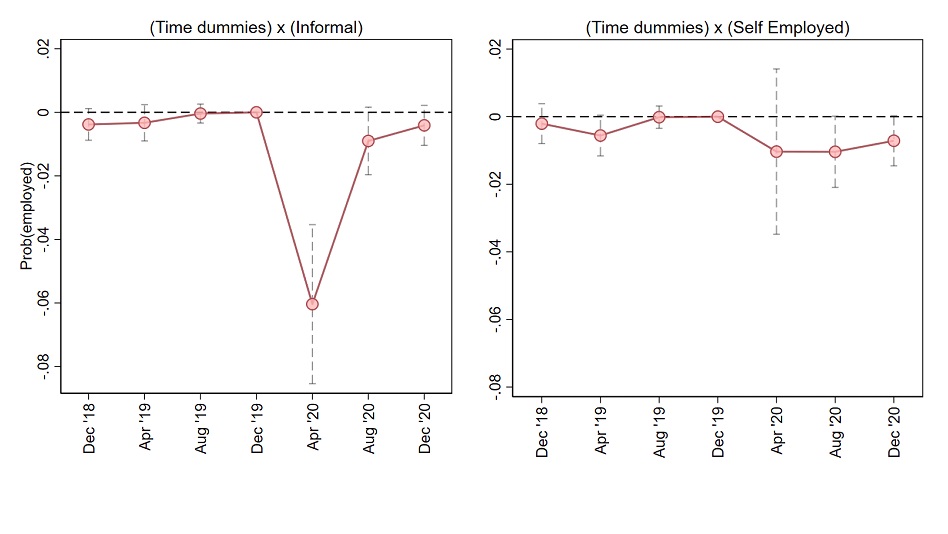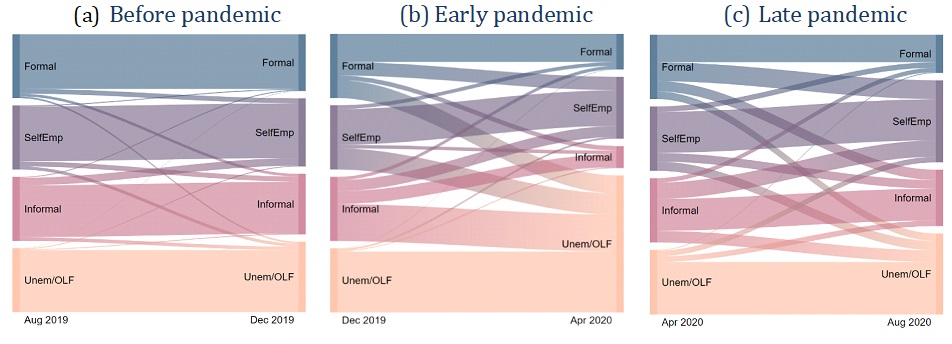Maurizio Bussolo[1], Ananya Kotia[2] and Siddharth Sharma[3]
Introduction
The COVID-19 pandemic is having unequal impacts across race, gender, age, and income groups, exacerbating pre-existing inequalities. This contribution focusses on the differential impact of the pandemic on an important dimension of emerging economy labour markets: informality. Informal workers are not covered by formal employment protection laws and social insurance programs, and are concentrated in small and micro-sized firms, which have limited cash reserves for paying employees in the event of insufficient earnings. They may have limited access to relief measures introduced by governments in response to the COVID-19 crisis. It is also likely that informal workers were less able to self-insure against this shock than formal workers, owing to lower levels of savings and poorer access to credit. We use a large panel data of workers to assess how informal workers have weathered the crisis as compared to formal workers in India.
Extensive margin of employment
We estimate difference-in-difference event study regressions to find that informal workers were significantly more likely to lose a job during the early period of pandemic (April-May 2020) than their formal counterparts. The left panel of Figure 1 shows this differential impact of the pandemic. The likelihood of an informal worker losing her job was 6% more than her formal counterpart in the same district and industry. As Figure 1 shows, before the pandemic, there was no such difference between the probability of being employed between these two worker categories. Because we control for district-time and industry-time fixed effects, the vulnerability of informal workers we report is not driven by their selection into specific industries like tourism and hospitality, which were disproportionately hit by the lockdown. To a lesser extent, self-employed individuals were also more vulnerable than formal workers (right panel, Figure 1).
Figure 1. Employment probability of informal and self-employed compared to formal workers

Labor market churning among the employed
The gap in employment outcomes between formal and informal workers was short-lived. By June 2020, there was no difference in the probability of employment between the two categories of workers. This quick “recovery” can also be seen in the country’s headline unemployment rate, which nearly returned to its pre-pandemic levels of 8-9%, after having risen by threefold in April-May 2020.
Figure 2 shows that these aggregate flows out of employment mask considerable churning in India’s labor market, which has continued well beyond April 2020. As compared to pre-pandemic transitions (August-December 2019), there was a strikingly large outflow of jobs from the formal sector into informality and self-employment during the lockdown (December 2019-April 2020). This outflow from formal jobs has continued steadily, even as lockdowns were eased in April-August 2020. Moreover, new jobs during the “recovery” have almost entirely come from the informal or self-employed sectors.
The gap in employment outcomes between formal and informal workers was short-lived. By June 2020, there was no difference in the probability of employment between the two categories of workers. This quick “recovery” can also be seen in the country’s headline unemployment rate, which nearly returned to its pre-pandemic levels of 8-9%, after having risen by threefold in April-May 2020.
Figure 2 shows that these aggregate flows towards unemployment and outside the labour force (OLF) mask considerable churning in India’s labour market, which has continued well beyond April 2020. As compared to pre-pandemic transitions (August-December 2019), there was a strikingly large outflow of jobs from the formal sector into informality and self-employment during the early pandemic phase (December 2019-April 2020). This outflow from formal jobs has continued steadily, even as lockdowns were eased in the late pandemic phase (April-August 2020). Moreover, new jobs during the “recovery” have almost entirely come from the informal or self-employed sectors.
Figure 2. Labour market churning: Comparison of employment probability.

Therefore, even though aggregate unemployment figures seem to have recovered to their pre-pandemic levels, persistent churning in the labour market has deteriorated the average quality of jobs in India.
Welfare
Like employment, there is a large overall negative impact on per-capita household income, with an additional penalty for informal workers (Figure 3, left panel). However, in contrast to employment, incomes of informal households recovered faster than those of formal workers: controlling for district-wave and industry-wave fixed effects, the estimated informal-formal income difference in June, July and August 2020 (relative to February 2020) is positive and statistically significant. In other words, their income level relative to formal workers had improved from its pre-COVID baseline.
Interestingly, despite larger initial income losses, informal workers are able to better protect their consumption relative to their formal counterparts (Figure 3, right panel). Understanding what is behind this puzzle of the differential trajectories of consumption and income is relevant for policymaking. This apparent puzzle may disappear if consumption were considered in real rather than nominal terms. There is some evidence that, due to pandemic related disruptions, food prices increased more than prices for other goods and given the fact that poorer, informal households purchase a larger share of food their welfare impact vis-à-vis that of formal households may have been worse than that suggested by considering nominal consumption. Another possible explanation of this puzzle is that it is due to forced saving of the formal households who were prevented, relatively more than informal households, from consuming certain goods and services due to the lockdown. In this case, we would expect a relatively rapid recovery of consumption demand among richer households in the coming year.
Figure 3. Per capita income and consumption of informal compared to formal workers

[1] World Bank:
[2] Dept of Economics, London School of Economics:
[3] World Bank:









